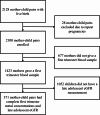Prenatal metal exposures and kidney function in adolescence in Project Viva
- PMID: 39478558
- PMCID: PMC11526622
- DOI: 10.1186/s12940-024-01135-6
Prenatal metal exposures and kidney function in adolescence in Project Viva
Abstract
Background: The developing kidney is vulnerable to prenatal environmental factors such as metal exposure, potentially altering the risk of later-life kidney dysfunction. This study examines the relationship between prenatal metal exposures, individually and as mixtures, and adolescent kidney function in Project Viva, a prospective longitudinal birth cohort in Massachusetts, USA.
Methods: We used data on metals measured in blood during pregnancy including 15 in the first trimester and four in the second trimester. We calculated estimated glomerular filtration rate (eGFR) in adolescents (mean: 17.7 years) using cystatin C- (eGFRcys) and creatinine-based (eGFRcreat) equations for children. We used linear regression for single metal analyses, and Bayesian kernel machine regression and quantile-based g-computation for mixture analyses, adjusting for relevant covariates. To account for multiple comparisons in the single metal analyses, we applied the Holm-Bonferroni procedure to control the false discovery rate.
Results: This study included 371 participants with first trimester metals and adolescent eGFR, and 256 with second trimester metals. Each doubling in first trimester cadmium concentration was associated with lower adolescent eGFRcys (β:-1.51; 95% CI:-2.83, -0.18). Each doubling in first trimester chromium (β:-1.45; 95% CI:-2.71, -0.19), nickel (β:-1.91; 95% CI:-3.65, -0.16), and vanadium (β:-1.69; 95% CI:-3.21, -0.17) was associated with lower adolescent eGFRcreat. After adjusting for multiple comparisons, p-values for associations between adolescent eGFR and chromium, nickel, vanadium and cadmium did not meet the criteria for significance. Metal mixture analyses did not identify statistically significant associations with adolescent eGFR.
Conclusions: These findings have important implications for future studies investigating the potential mechanisms through which prenatal metal exposures affect long-term kidney health in children.
Keywords: Cohort; Environmental exposure; Epidemiology; Metals; Mixtures; Renal development.
© 2024. The Author(s).
Conflict of interest statement
The authors declare no competing interests.
Figures



References
-
- Solhaug MJ, Bolger PM, Jose PA. The developing kidney and environmental toxins. Pediatrics. 2004;113(4 Suppl):1084–91. - PubMed
MeSH terms
Substances
Grants and funding
LinkOut - more resources
Full Text Sources
Research Materials
Miscellaneous

